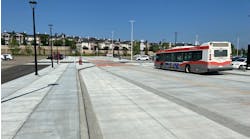Research Brief: Park-and-ride transit gives suburban commuters higher access to jobs
Park-and-ride facilities enable many suburban and exurban commuters in the Twin Cities metro area to reach roughly as many jobs as urban transit users, according to a first-of-its-kind study from the Accessibility Observatory at the University of Minnesota. The Observatory’s new method, just published in Transportation Research Record, incorporates park-and-ride trips into transit accessibility evaluations.
“This analysis shows how park-and-ride investments translate to economic opportunity for suburban and exurban residents,” said Kristin Carlson, a researcher with the Accessibility Observatory and author of the study. “Our new data can inform transit operators and the Minnesota Department of Transportation on facility placement, travel behavior and future investment.”
Researchers analyzed how modeling connections between automobile and public transit at park-and-ride facilities provides a more detailed view of the job accessibility available to Twin Cities commuters. Job accessibility is three times greater for those who can drive to park-and-ride facilities compared to those who walk to transit. Park-and-ride service makes transit accessibility levels in the suburbs more competitive with automobile levels during the morning commute.
By dedicating space to park personal vehicles, park-and-ride facilities expand the reach of transit service in otherwise low density regions, such as Brooklyn Park and Maplewood. Park-and-ride systems exist across the nation and offer commuters an alternative to driving to and parking at a final destination. In the Twin Cities metro, clusters of park-and-ride facilities are located at the junction of I-694 and Highway 252, and along I-394. They are easily accessed from the freeway and give riders multiple parking and route options. These zones experience higher park-and-ride accessibility than neighboring areas for the same travel time.
A more complete understanding of the costs and benefits of park-and-ride facilities and services can improve transportation planning. The methodology and tools developed in the Twin Cities case study can also be applied to transit accessibility analyses across the nation. Key findings of this study include:
- the regional park-and-ride system improves transit accessibility for those with access to a vehicle;
- park-and-ride facilities make public transit more competitive with automobile commuting in the suburbs when considering access to jobs;
- the park-and-ride accessibility profile is a blend of automobile and transit accessibility patterns across the Twin Cities metropolitan region.
Future research on the impacts to travel behavior would benefit travel demand modeling efforts by transportation authorities and city planners. Funding for this study was provided by the Minnesota Department of Transportation.

